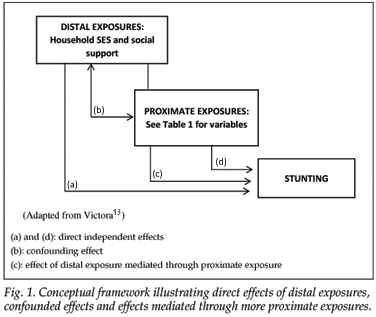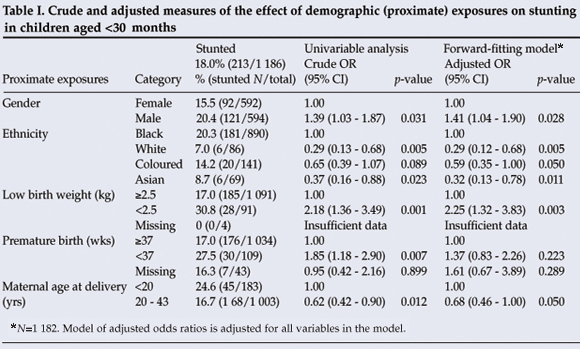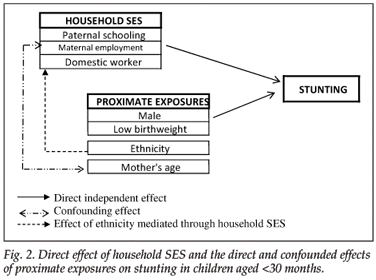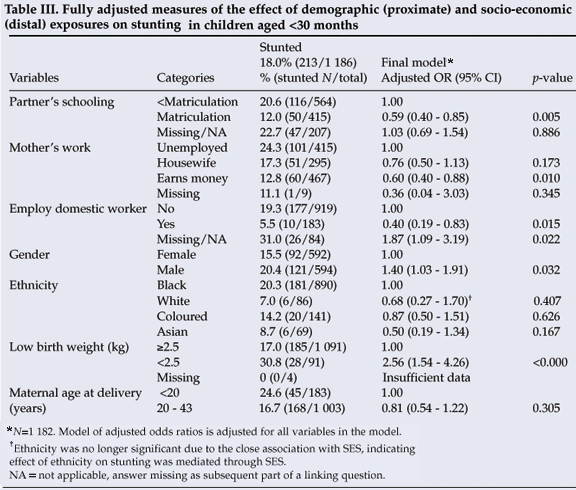Services on Demand
Article
Indicators
Related links
-
 Cited by Google
Cited by Google -
 Similars in Google
Similars in Google
Share
SAMJ: South African Medical Journal
On-line version ISSN 2078-5135
Print version ISSN 0256-9574
SAMJ, S. Afr. med. j. vol.99 n.6 Pretoria Jun. 2009
ORIGINAL ARTICLES
Socio-economic predictors of stunting in preschool children – a population-based study from Johannesburg and Soweto
Barbara A WilleyI, *; Noel CameronII; Shane A NorrisIV; John M PettiforV; Paula L GriffithsIII
IBA, MSc, PhD, Department of Infectious and Tropical Disease, London School of Hygiene & Tropical Medicine, London, UK
IIBEd (Hons), MSc, PhD, Department of Human Sciences, Loughborough University, Loughborough, UK
IIIBSc, PhD, Department of Human Sciences, Loughborough University, Loughborough, UK
IVBSc (Hons), PhD, Mineral Metabolism Research Unit, Department of Paediatrics, University of the Witwatersrand, Johannesburg
VMB BCh, PhD (Med), FCPaed (SA), Mineral Metabolism Research Unit, Department of Paediatrics, University of the Witwatersrand, Johannesburg
ABSTRACT
BACKGROUND: Stunting continues to be a child public health concern in many African countries, including South Africa. This study uses data from the Birth to Twenty study, held in Johannesburg, to investigate a range of household-level socio-economic and social support predictors of stunting in children aged less than 30 months.
DESIGN: Logistical regression models were constructed using a conceptual framework to investigate the association between early life measures of socio-economic status and stunting (<–2 standard deviations from the WHO (2006) standard), using data collected in the Birth to Twenty study.
RESULTS: Stunting prevalence was 18.0% (213/1 186). In unadjusted analyses, numerous socio-economic status exposures showed significant associations with stunting; however, in final multivariable models, decreased likelihood of stunting was seen in children born to mothers who were employed (adjusted odds ratio (AOR)=0.60, 95% confidence interval (CI) 0.40 - 0.88), those with fathers who had completed secondary school (AOR=0.59, 95% CI 0.40 - 0.85), and whose parents employed a domestic worker (AOR=0.40, 95% CI 0.19 - 0.83), while increased likelihood of stunting was seen in male children (AOR=1.40, 95% CI 1.03 - 1.91), and those born of low birth weight (AOR=2.56, 95% CI 1.54 - 4.26).
CONCLUSIONS: Stunting and child malnutrition remain policy priorities for the South African Department of Health, and this study suggests that policies that aim to increase parental education level and reduce unemployment or target additional support to families with low education or unemployed parents may reduce stunting in preschool-age children in this setting.
Childhood stunting continues to be a public health issue in many African countries, with a prevalence in children aged <3 years ranging from 27.2% to 44.9%, based on recent data from sub-Saharan Africa from the Demographic and Health Surveys programme.1 South African Department of Health figures report a prevalence of stunting in this age group at the lower end of this range (25.5%).2
The consequences of stunting in early life include increased susceptibility to infectious diseases, attenuated cognitive ability and increased behavioural problems in childhood,3 reduced final height, and increased risk of child and adult obesity.4 This wide range of effects is particularly relevant in a setting experiencing a combined burden of infectious and non-communicable lifestyle-related diseases, as is the case in South Africa.5
Stunting is principally caused by inadequate or inappropriate nutrition and the impact of infectious disease, including untreated paediatric HIV infection.y Appropriate weaning and complementary feeding behaviours, nutritional interventions, and disease control and treatment programmes are strategies to prevent stunting. However, their effectiveness also depends on counteracting the environmental and socio-economic circumstances that allow infection and sub-optimal nutrition to persist.
Most studies of the socio-economic status (SES) predictors of stunting in African settings emphasise the importance of maternal education,7 provision of household water and sanitation services,8 and household wealth or income (estimated by ownership of consumer durables).9 Few studies have investigated the impact of both social and economic aspects of SES on stunting within an African setting, and studies tend not to include a wide range of household SES measures.
The Birth to Twenty (Bt20) study was established in 1990, as a long-term (20 years) study of a representative population of infants born in all districts of Johannesburg and Soweto between April and June 1990.10 Follow-up on this cohort (N= 3 273) is ongoing, and data on their growth, development, and a wide range of household SES and social support measures are available. Using data from the Bt20 study, this paper investigates associations between stunting and early-life household SES, social support, and demographic factors, in children aged <30 months.
Methods
Measures
Measures of household SES and social support in the Bt20 study were predominantly drawn from questionnaires administered to mothers at baseline (antenatally), with information on the family dwelling collected 6 months post partum. The measures included parental education and employment; household water, sanitation and electricity supply; ownership of consumer durables; type of cooking fuel used; health insurance; employment of a domestic worker; and characteristics of the family's dwelling (e.g. type of structure, number of rooms, separate kitchen, roofing materials). Social measures included marital status, support from a partner, membership of an organisation, network of people with whom to discuss problems or from whom to ask for help, and support during pregnancy (e.g. whether pregnancy was wanted, and is family ready for the pregnancy).
Birth weight, gestational age, gender, maternal age at delivery and ethnicity were obtained from birth records and hospital obstetric records. Height was assessed at 3 and 6 months and annually from 12 months onwards by Bt20 investigators trained in the techniques of standardised growth measurement, who visited participants at their homes. Height was measured once using a portable infantometer or Holtain stadiometer and recorded to the nearest 0.1 cm. Reliability was by test-retest evaluation and monitoring of quality control throughout the study. Stunting was defined as a height-for-age z-score of >2 standard deviations below the median, using the age and sex-specific international growth standards developed by the World Health Organization (WHO) in their Multicenter Growth Reference Study.11
Data from assessments at approximately 3, 6, 12 or 24 months of age were used to calculate the prevalence of stunting at any age in children <30 months at assessment. Where length or height was available for >1 assessment (8.3% of children had data from all 4 assessments), the latest was included, as such children were included only once in analyses. Prevalence as opposed to rates of stunting over time was used, as the majority (>60%) of children had assessments at only one time point, principally owing to difficulty in retaining contact with this mobile population at a time of substantial social transition in South Africa.12
Statistical analysis
All analyses were conducted in Stata 10.0 (Stata Corporation, College Station, Texas, USA). We used forward stepwise logistical regression to identify potential explanatory variables associated with stunting, and initially developed two regression models. The first identified demographic, or proximate, measures, and the second identified SES and social support measures associated with stunting. Variables included were identified from univariable analyses, where exposures showing a strength of association of p<0.10 with stunting were selected. These variables were added to the model one at a time, with those showing the strongest association being added first. Those that did not significantly add to the stepwise model (p>0.05) were not retained. We used backward stepwise regression to check the validity of the models.
A final logistical regression model was built combining the first two, according to a conceptual framework (Fig. 1). This framework, adapted from Victora et al.,13 enables groups of variables to be conceptualised as distal or proximate influences on stunting. Within this framework, effects of distal variables may be direct (Fig. 1a), confounded (Fig. 1b) or mediated through the effect of proximate variables (Fig. 1c). Likewise, the effect of proximate variables may also be confounded (Fig. 1b) or direct (Fig. 1d). The effect of distal variables in the final model was tested by comparing nested models, using likelihood regression tests.

Results
Sample characteristics
These analyses include 1 186 children for whom complete height or length, age and gender data were available, representing 36.2% of the Bt20 study; in comparison with the baseline cohort, more of the children included were born to black mothers (p<0.001). However, no significant difference (p>0.05) was seen for >15 other demographic and SES variables available for comparison when investigated, using chi-square tests to compare proportions and Kruskal-Wallis tests to compare medians (data not shown here).
The median age of the children was 23.2 months (interquartile range (IQR) 11.8 - 24.6 months), and similar proportions of boys and girls were seen; most (75.0%) were born to black mothers. In total, 9.2% of infants were premature (<37 weeks) and 7.7% were of low birth weight (LBW) (<2 500 g). A total of 15.4% were born to mothers aged <20 years at delivery; the median age of the mothers was 25 years (IQR 21 - 30 years).
Most of the children were born into low SES households: 72% were born to mothers who had not completed secondary school, and 35% to mothers who were unemployed, while 35% were from homes with indoor hot water and 40.6% from homes with an indoor flush toilet. Although 60.1% of children's mothers were single (never married), almost half (47.5%) lived with partners; 58.0% of children's mothers reported during their pregnancy that they did not want the pregnancy or were unsure (although 72% felt that the family was ready for the arrival of a new child).
Stunting
A total of 213 children aged <3 years (18.0%, 95% confidence interval (CI) 15.8 - 20.1%) were defined as stunted; 52.3% had height data available from the 2-year assessment (N=621, age 22.5 - 29.0 months) and 24.5% were stunted (N=152). Of the remainder, 35.2% had data from the 1-year assessment (N=418, age 9.2 - 13.5 months), 7.7% of whom were stunted (N=32). Lastly, 12.4% had data available from the 6-month assessment (N=147, age 4.9 - 9.0 months), of whom 19.7% were stunted (N=29).
Table I shows results from both the univariable analysis and the first forward-fitted multivariable logistical regression model (N=1 182), illustrating the effects of demographic variables on stunting (Fig. 1). Male gender (AOR=1.41, 95% CI 1.04 - 1.90) and low birth weight (LBW) (AOR=2.25, 95% CI 1.32 - 3.83) showed increased likelihood of stunting. Decreased likelihood of stunting was seen in children born to mothers >20 years at delivery (AOR=0.68, 95% CI 0.46 - 1.00), and in children born to white (AOR=0.29, 95% CI 0.12 - 0.68), coloured (AOR=0.59, 95% CI 0.35 - 1.00) or Asian (AOR=0.32, 95% CI 0.13 - 0.78) mothers, in comparison with those born to black mothers.

In univariable analyses, higher levels of parental education, maternal employment, and monthly frequency of partner's pay were associated with reduced likelihood of stunting (Table II). Access to indoor hot water, an indoor flush toilet, electricity for cooking, ownership of a fridge or washing machine, employment of a domestic worker and private health insurance were also associated with reduced likelihood of stunting. Social measures also showed reduced likelihood of stunting in cases of a married mother, a mother who cohabited with a partner, a father who was resident in the home, and having been born to a mother who, when pregnant, reported that she felt her family was ready for the pregnancy (Table II).
Results from the second multivariable logistical regression model (N=1 178) indicated a reduced likelihood of stunting for children whose fathers had completed secondary school (AOR=0.64, 95% CI 0.43 - 0.95), whose mothers were employed (AOR=0.59, 95% CI 0.40 - 0.89), and whose parents employed a domestic worker (AOR=0.38, 95% CI 0.18 - 0.82) (Table II). The effects of the other economic SES variables significant in univariable analyses and the effect of social variables were attenuated and no longer significant, principally owing to colinearity with mother's employment (results not shown). Similarly, the effect of the frequency of father's pay and mother's schooling level was strongly attenuated owing to colinearity with father's schooling (results not shown).
SES and demographic predictors
Fig. 2 and Table III illustrate the combined effect of significant socio-economic (distal) variables and demographic (proximate) variables on stunting. Odds ratios (ORs) for stunting from this multivariable model (N=1 182) are adjusted for all variables in the model, and indicate that children whose fathers had completed secondary school (AOR=0.59, 95% CI 0.40 - 0.85), whose mothers were employed (AOR= 0.60, 95% CI 0.40 - 0.88) and whose parents employed a domestic worker (AOR=0.40, 95% CI 0.19 - 0.83) were at reduced likelihood of stunting, while male children (AOR=1.40, 95% CI 1.03 - 1.91) and those born with LBW (AOR=2.56, 95% CI 1.54 - 4.26) were at increased likelihood of stunting (Table III).


Likelihood ratio tests comparing nested models indicated that these SES measures significantly added to the final model (χ2=35.7, p=0.001). There was little difference between ORs on stunting before proximate exposures were included (Table II) and those seen after their inclusion (Table III), suggesting that the effects of these SES variables were not mediated though gender or LBW delivery (Fig. 2). The use of a conceptual framework also helped to illustrate that the crude effect of ethnicity on stunting was mediated through mother's employment, father's education and parents who could afford to employ a domestic worker, and that the effect of mother's age was confounded by maternal employment status (Fig. 2).
Discussion
We examined the association between early life measures of household SES and stunting in a population-based sample of 1 186 urban South African children aged <30 months. The prevalence of stunting was 18.0%, which is lower than recent national estimates of 25.5% for children aged <3 years, using National Center for Health Statistics (NCHS)/WHO 1978 growth references.2 Children from rural and urban areas were included in these national estimates, and the influence of untreated paediatric HIV infection might have caused a rise in prevalence, compared with our estimates dating from the early 1990s.
Maternal employment, paternal education and employment of a domestic worker showed protective effects on stunting. As illustrated by the conceptual framework, the effect of these SES variables was not mediated through the proximate variables of gender or LBW delivery. However, from the results of other studies, it is expected that if likely mediators such as nutrition, breastfeeding, weaning, morbidity (including untreated paediatric HIV infection), and use of health services were available, the effect on stunting of the SES variables significant in this study would be mostly indirect.
Maternal employment has a complex relationship with childhood stunting, and the cessation or interruption of exclusive breastfeeding may have a large negative effect on the growth of infants and young toddlers.14 Our results are consistent with studies that have reported a protective effect from maternal employment, showing that the increased income and increased female autonomy associated with employment may positively influence food security, diet quality15 and use of health services.16
Although the pathways through which paternal education may influence stunting have been less frequently investigated, work from Indonesia and Bangladesh suggests that these may include health-promoting behaviours such as childhood vaccination, family planning, attendance at the local health clinic and vitamin A supplementation.17 Among the Bt20 families, paternal education was strongly correlated with maternal education level. Extensive research from developing countries on the role of maternal education suggests that it may influence child growth and health through better feeding practices and home hygiene,18 and health-seeking behaviour.19 In the present study, the colinearity between paternal and maternal education resulted in attenuation of the effect of maternal education on child stunting.
In this study, the SES measure of employing a domestic worker is likely to be a marker of household wealth and disposable income. Proxy measures of household wealth frequently show associations with child growth in developing countries, and are suggested to act via improved nutrition and health-seeking behaviour.20
Unadjusted results from this study suggest a lower likelihood of stunting in children whose mothers believed that their family was ready for the pregnancy; however, when adjusted for maternal employment, this effect was no longer significant. Although the role of social support in child growth has not been widely investigated in African countries, studies report associations between low pregnancy commitment, low levels of social support, mistimed pregnancy and maternal depression,21 which in turn show associations with poor levels of mother-infant/child interaction and stunting.22 Previous work on the Bt20 study has show associations between mother's desire for her pregnancy and small-for-gestational-age delivery (<10th centile of birth weight for gestational age), suggesting that social support during pregnancy may influence child growth early in life in this urban South African context.23
The optimal growth of infants and young children has been identified in the Integrated Nutrition Policy, and reiterated in the South African National Health Plan 2007/2008, as a key public health priority. The relevance of stunting to child public health in South Africa is increased by the expanding HIV epidemic, the continuing risk of vertical transmission of the virus, and incomplete coverage of antiretroviral treatment for all infected infants and children.6 Identifying context-specific socio-economic and social support risk factors for stunting in South Africa can contribute to fulfilling these priorities by identifying targets for policy. Based on results from this study, policies promoting parental education and employment are likely to improve child growth in this urban African context.
The Bt20 study receives funding and logistical support from the Medical Research Council of South Africa, Human Sciences Research Council of South Africa, University of the Witwatersrand, Wellcome Trust (UK), and the Anglo-American Chairman's Fund. Analysis of the Bt20 socio-economic and social support data was supported by the Parkes Foundation, Cambridge University, and the Ruggles-Gates Fund for Biological Anthropology, Royal Anthropological Institute of Great Britain & Ireland. Analyses were completed as part of doctorate work carried out by the first author, who received a PhD studentship from the Department of Human Sciences, Loughborough University, UK. The last author's involvement in the research is supported by an MRC, UK grant (id 70363).
Ethical approval for the Bt20 cohort study was obtained from the Ethics Board of the University of the Witwatersrand (protocol number: M980810). Fieldwork and analyses relevant to socio-economic variables in the Bt20 cohort received ethical approval from Loughborough University and the University of the Witwatersrand (protocol number: 03-11-40).
References
1. Fotso JC, Kuate-Defo B. Household and community socioeconomic influences on early childhood malnutrition in Africa. J Biosoc Sci 2006; 38(3): 289-313. [ Links ]
2. Labadarios D, Maunder E, Steyn N, et al. National food consumption survey in children aged 1-9 years: South Africa 1999. Forum Nutr 2003; 56: 106-109. [ Links ]
3. Berkman DS, Lescano AG, Gilman RH, Lopez SL, Black MM. Effects of stunting, diarrhoeal disease, and parasitic infection during infancy on cognition in late childhood: a follow-up study. Lancet 2002; 359(9306): 564-571. [ Links ]
4. Sawaya AL, Dallal G, Solymos G, et al. Obesity and malnutrition in a Shantytown population in the city of Sao Paulo, Brazil. Obes Res 1995; 3 Suppl 2: 107s-115s. [ Links ]
5. Tollman SM, Kahn K, Sartorius B, Collinson MA, Clark SJ, Garenne ML. Implications of mortality transition for primary health care in rural South Africa: a population-based surveillance study. Lancet 2008; 372: 893-901. [ Links ]
6. Kabue MM, Kekitiinwa A, Maganda A, Risser JM, Chan W, Kline MW. Growth in HIV-infected children receiving antiretroviral therapy at a pediatric infectious diseases clinic in Uganda. Aids Patient Care and STDs 2008; 22(3): 245-251. [ Links ]
7. Wamani H, Astrom AN, Peterson S, Tumwine JK, Tylleskar T. Predictors of poor anthropometric status among children under 2 years of age in rural Uganda. Public Health Nutr 2006; 9(3): 320-326. [ Links ]
8. Pongou R, Ezzati M, Salomon JA. Household and community socioeconomic and environmental determinants of child nutritional status in Cameroon. BMC Public Health 2006; 6: 98. [ Links ]
9. Bollen KA, Glanville JL, Stecklov G. Socioeconomic status and class in studies of fertility and health in developing countries. Annu Rev Sociol 2001; 27: 153-185. [ Links ]
10. Richter LM, Norris SA, De Wet T. Transition from Birth to Ten to Birth to Twenty: the South African cohort reaches 13 years of age. Paediatr Perinat Epidemiol 2004; 18(4): 290-301. [ Links ]
11. World Health Organization. WHO Child Growth Standards based on length/height, weight and age. Acta Paediatr Suppl 2006; 450: 76-85. [ Links ]
12. Norris N, Richter N, Fleetwood S. Panel studies in developing countries: case analysis of sample attrition over the past 16 years within the birth to twenty cohort in Johannesburg, South Africa. J Int Development 2007; 19(8): 1143-1150. [ Links ]
13. Victora CG, Huttly SR, Fuchs SC, Olinto MT. The role of conceptual frameworks in epidemiological analysis: a hierarchical approach. Int J Epidemiol 1997; 26(1): 224-227. [ Links ]
14. Ukwuani FA, Suchindran CM. Implications of women's work for child nutritional status in sub-Saharan Africa: a case study of Nigeria. Soc Sci Med 2003; 56(10): 2109-2121. [ Links ]
15. Boyle MH, Racine Y, Georgiades K, et al. The influence of economic development level, household wealth and maternal education on child health in the developing world. Soc Sci Med 2006; 63(8): 2242-2254. [ Links ]
16. Njau JD, Goodman C, Kachur SP, et al. Fever treatment and household wealth: the challenge posed for rolling out combination therapy for malaria. Trop Med Int Health 2006; 11(3): 299-313. [ Links ]
17. Semba RD, de Pee S, Sun K, Sari M, Akhter N, Bloem MW. Effect of parental formal education on risk of child stunting in Indonesia and Bangladesh: a cross-sectional study. Lancet 2008; 371(9609): 322-328. [ Links ]
18. Armar-Klemesu M, Ruel MT, Maxwell DG, Levin CE, Morris SS. Poor maternal schooling is the main constraint to good child care practices in Accra. J Nutr 2000; 130(6): 1597-1607. [ Links ]
19. Levine RA, Levine SE, Richman A, Uribe FMT, Correa CS, Miller PM. Womens Schooling and Child-Care in the Demographic-Transition – a Mexican Case-Study. Population and Development Review 1991; 17(3): 459-496. [ Links ]
20. Mahmud Khan M, Hotchkiss DR, Berruti AA, Hutchinson PL. Geographic aspects of poverty and health in Tanzania: does living in a poor area matter? Health Policy Plan 2006; 21(2): 110-122. [ Links ]
21. Kost K, Landry DJ, Darroch JE. The effects of pregnancy planning status on birth outcomes and infant care. Fam Plann Perspect 1998; 30(5): 223-230. [ Links ]
22. Rahman A, Iqbal Z, Bunn J, Lovel H, Harrington R. Impact of maternal depression on infant nutritional status and illness: a cohort study. Arch Gen Psychiatry 2004; 61(9): 946-952. [ Links ]
23. Willey B, Griffiths P, Cameron N, Norris S, Pettifor J. Socio-economic status and social support as predictors of infants being born small for gestational age in urban South Africa. In: Nicoletti I, Benso L, Gilli G, eds. Human Growth in Sickness and in Health: Plenary Lectures from the 10th International Congress of Auxology. Frienze: Edizioni Centro Studi Auxologici, 2006. [ Links ]
* Corresponding author: B Willey (Barbara.Willey@lshtm.ac.uk)














